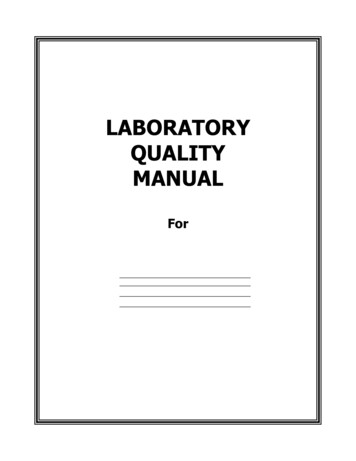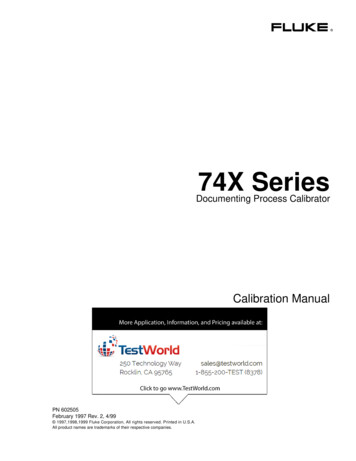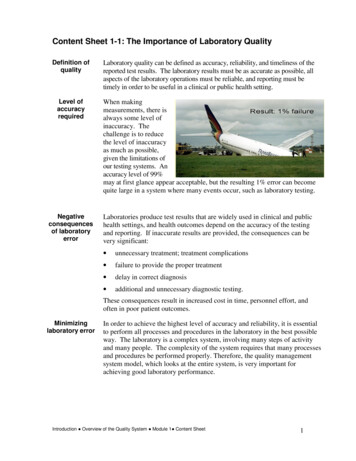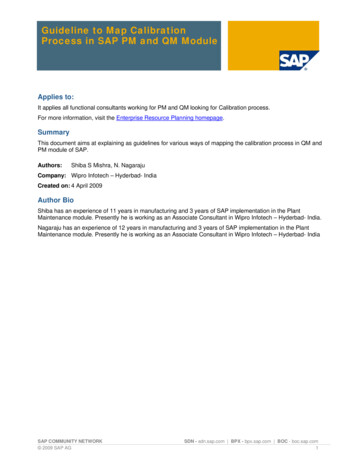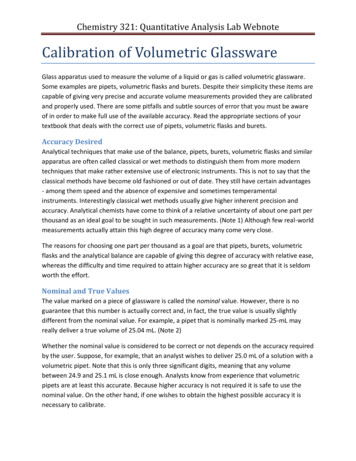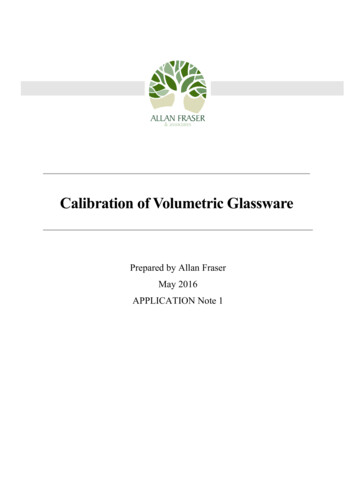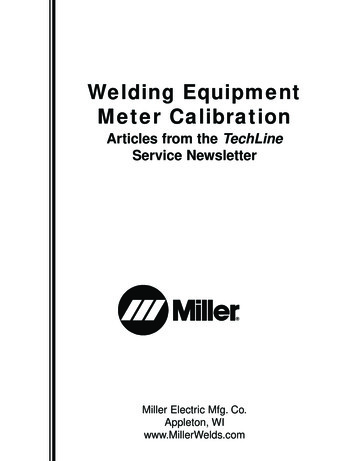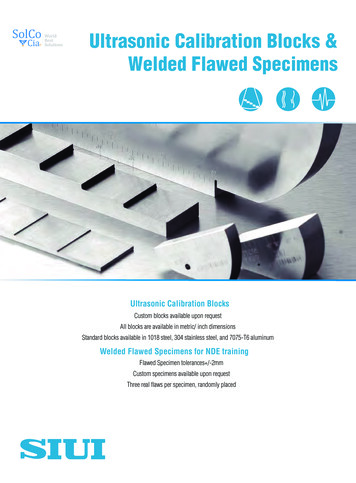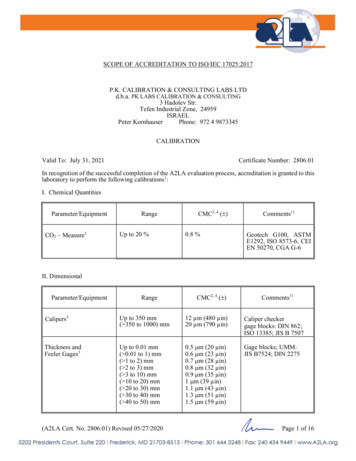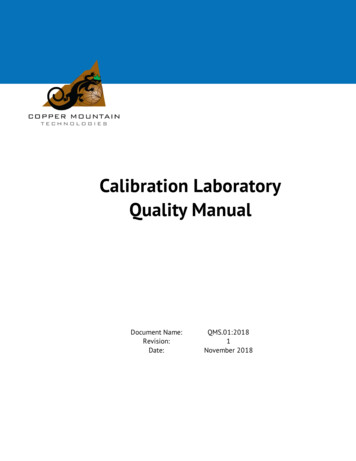
Transcription
Copper Mountain TechnologiesCalibration LaboratoryQuality ManualDocument Name:Revision:Date:QMS.01:20181November 2018
Copper Mountain TechnologiesDOCUMENT CHANGE RECORDRevision DateBrief Description of Changes18-November-2018The manual cancels and replaces the QMS.01:2015, which hasbeen technically revised.Document Name: QMS.01:2018Page 2 of 58Revision: 1
Copper Mountain TechnologiesDocument Name: QMS.01:2018Page 3 of 58Revision: 1
Copper Mountain TechnologiesCONTENTSDOCUMENT CHANGE RECORD . 2CONTENTS . 4AUTHORIZATION APPROVALS . 6DISTRIBUTION . 61 SCOPE . 72 NORMATIVE REFERENCES . 73 TERMS AND DEFINITIONS . 74 MANAGEMENT REQUIREMENTS . 74.1 Impartiality .74.2 Confidentiality .85 STRUCTURAL REQUIREMENTS . 96 RESOURCE REQUIREMENTS . 106.1 General . 106.2 Personnel . 106.3 Facilities and environmental conditions . 116.4 Equipment. 116.5 Metrological traceability . 136.6 Externally provided products and services . 147 PROCESS REQUIREMENTS . 157.1 Review of requests, tenders and contracts . 157.2 Selection, verification and validation of methods . 167.3 Sampling. 177.4 Handling of test or calibration items . 177.5 Technical records . 187.6 Evaluation of measurement uncertainty . 187.7 Ensuring the validity of results . 197.8 Reporting of results . 20Document Name: QMS.01:2018Page 4 of 58Revision: 1
Copper Mountain Technologies7.9 Complaints . 257.10 Nonconforming work . 267.11 Control of data and information management . 278 MANAGEMENT SYSTEM REQUIREMENTS . 288.1 Options . 288.2 Management system documentation (Option A) . 288.3 Control of management system documents (Option A) . 298.4 Control of records (Option A) . 298.5 Actions to address risks and opportunities (Option A) . 308.6 Improvement (Option A). 308.7 Corrective actions (Option A) . 308.8 Internal audits (Option A) . 318.9 Management reviews (Option A) . 319 USE OF ACCREDITATION BODY SYMBOL . 33ANNEX A ORGANIZATION CHART . 34ANNEX B PROCESSES INTERACTION CHART . 35ANNEX C QUALITY POLICY STATEMENT. 53ANNEX D STRUCTURE OF DOCUMENTATION . 56ANNEX E PERSONNEL COMPETENCE. 57Document Name: QMS.01:2018Page 5 of 58Revision: 1
Copper Mountain TechnologiesAUTHORIZATION APPROVALSElectronic authorization approval is the preferred method for approving quality systemdocuments. Signed hardcopies are only available upon request.Approver:Laboratory HeadApprover:Consulting EngineerDocument Reviewer:Quality ManagerDocument Owner:Quality ManagerDISTRIBUTIONPrinted copies of this document are uncontrolled and users must verify the revision iscurrent before use. All previous revisions must be discarded. Current documents and revisionindex are available on Copper Mountain Technologies network. All documents will have electronic approval. An uncontrolled copy is available to customers via the Copper MountainTechnologies website.Document Name: QMS.01:2018Page 6 of 58Revision: 1
Copper Mountain Technologies1 SCOPEThis Calibration Laboratory Quality Manual defines or identifies the policies, proceduresand requirements for the competence, impartiality and consistent operation that choose tocomply with the requirements of ISO/IEC 17025 as a calibration laboratory. This documentis applicable to all laboratory activities, regardless of accreditation exists. Any local documents, procedures and policies associated with ISO/IEC 17025 compliance for calibrationlaboratories must comply with this document.2 NORMATIVE REFERENCESThe following referenced documents are indispensable for the application of this document. For dated references, only the edition cited applies. For undated references, the latestedition of the referenced document (including any amendments) applies.ISO/IEC 17025 General requirements for the competence of testing and calibration laboratoriesISO/IEC Guide 99 International vocabulary of metrology – Basic and general conceptsand associated terms (VIM, also known as JCGM 200), issued by BIPM, IEC, IFCC, ISO, IUPAC,IUPAP and OIMLISO/IEC Guide 98-4 Uncertainty of measurement – Part 4: Role of measurement uncertainty in conformity assessment (also known as JCGM 106), issued by BIPM, IEC, IFCC, I L A C ,ISO, IUPAC, IUPAP and OIMLEURAMET Calibration Guide No. 12 Guidelines on the Evaluation of Vector Network Analyzers (VNA)3 TERMS AND DEFINITIONSFor the purposes of this document, the relevant terms and definitions given in VIM apply.4 MANAGEMENT REQUIREMENTS4.1 Impartiality4.1.1 Laboratory activities are undertaken impartially and structured and managed so asto safeguard impartiality.Document Name: QMS.01:2018Page 7 of 58Revision: 1
Copper Mountain Technologies4.1.2 The laboratory management is committed to impartiality.4.1.3 The laboratory is responsible for the impartiality of its laboratory activities anddoes not allow commercial, financial or other pressures to compromise impartiality.4.1.4 The laboratory identifies risks to its impartiality on an on-going basis. This includesthose risks that arise from its activities, or from its relationships, or from the relationshipsof its personnel. However, such relationships do not necessarily present a laboratory with arisk to impartiality.4.1.5 If a risk to impartiality is identified, the laboratory is able to demonstrate how iteliminates or minimizes such risk.4.2 Confidentiality4.2.1 The laboratory is responsible, through legally enforceable commitments, for themanagement of all information obtained or created during the performance of laboratoryactivities. The laboratory informs the customer in advance, of the information it intends toplace in the public domain. Except for information that the customer makes publicly available, or when agreed between the laboratory and the customer (e.g. for the purpose of responding to complaints), all other information is considered proprietary information and isregarded as confidential.4.2.2 When the laboratory is required by law or authorized by contractual arrangements to release confidential information, the customer or individual concerned is, unlessprohibited by law, notified of the information provided.4.2.3 Information about the customer obtained from sources other than the customer (e.g.complainant, regulators) is confidential between the customer and the laboratory. The provider (source) of this information is confidential to the laboratory and is not be sharedwith the customer, unless agreed by the source.4.2.4 Personnel, including any committee members, contractors, personnel of externalbodies, or individuals acting on the laboratory's behalf, keep confidential all information obtained or created during the performance of laboratory activities, except as required by law.Document Name: QMS.01:2018Page 8 of 58Revision: 1
Copper Mountain Technologies5 STRUCTURAL REQUIREMENTS5.1 The laboratory is a defined part of Copper Mountain Technologies that is legally responsible for its laboratory activities.5.2 The laboratory has identified management that has overall responsibility for the laboratory (annex A).5.3 The laboratory has defined and documented the range of laboratory activities forwhich it conforms with this document. Copper Mountain Technologies laboratory performscalibration activities. The laboratory only claims conformity with this document for thisrange of laboratory activities, which excludes externally provided laboratory activities on anongoing basis. Laboratory whose work includes both accredited and non-accredited calibrations complies to this document, but non-accredited calibrations are not required to fullycomply with sections 6.5, 7.6 and reporting requirements of 7.8.5.4 Laboratory activities are carried out in such a way as to meet the requirementsof this document, the laboratory’s customers, regulatory authorities and organizationsproviding recognition. This includes laboratory activities performed in its permanent facilities.5.5 The laboratory has (annex B):a) defined the organization and management structure of the laboratory, its place inparent organization (see also annex A), and the relationships between management, technicaloperations and support services. The structure is described to a level of detail sufficient toidentify key personnel / activities and in order to reveal possible conflicts of interest involvingboth calibration services and manufacturing activities involving calibration;b) specified the responsibility, authority and interrelationship of all personnel who manage, perform or verify work affecting the results of laboratory activities;c) documented its procedures to the extent necessary to ensure the consistent application of its laboratory activities and the validity of the results.5.6 The laboratory has personnel named as a quality manager who, irrespective of otherresponsibilities, have the authority and resources needed to carry out their duties, including:a) implementation, maintenance and improvement of the management system;b) identification of deviations from the management system or from the proceduresfor performing laboratory activities;c) initiation of actions to prevent or minimize such deviations;Document Name: QMS.01:2018Page 9 of 58Revision: 1
Copper Mountain Technologiesd) reporting to laboratory management on the performance of the management systemand any need for improvement;e) ensuring the effectiveness of laboratory activities.NOTE Individuals may be assigned more than one function and it may be impractical toappoint deputes for every function.5.7 Laboratory management ensures that:a) communication takes place regarding the effectiveness of the management systemand the importance of meeting customers’ and other requirements;b) the integrity of the management system is maintained when changes to the management system are planned and implemented.6 RESOURCE REQUIREMENTS6.1 GeneralThe laboratory has available the personnel, facilities, equipment, systems and supportservices necessary to manage and perform its laboratory activities.6.2 Personnel6.2.1 All personnel of the laboratory, either internal or external, that could influencethe laboratory activities act impartially, are competent and work in accordance with the laboratory's management system.6.2.2 The laboratory documents the competence requirements for each function influencing the results of laboratory activities, including requirements for education, qualification, training, technical knowledge, skills and experience.6.2.3 The laboratory ensures that the personnel have the competence to performlaboratory activities for which they are responsible and to evaluate the significance of deviations.6.2.4 The management of the laboratory communicates to personnel their duties, responsibilities and authorities.6.2.5 The laboratory has procedure (s) and retains records for:a) determining the competence requirements;b) selection of personnel;c) training of personnel;Document Name: QMS.01:2018Page 10 of 58Revision: 1
Copper Mountain Technologiesd) supervision of personnel;e) authorization of personnel;f) monitoring competence of personnel.6.2.6 The laboratory authorizes personnel to perform specific laboratory activities, including but not limited to, the following:a) development, modification, verification and validation of methods;b) analysis of results, including statements of conformity or opinions and interpretations;c) report, review and authorization of results.6.3 Facilities and environmental conditions6.3.1 The facilities and environmental conditions are suitable for the laboratory activities and not adversely affect the validity of results.6.3.2 The requirements for facilities and environmental conditions necessary for theperformance of the laboratory activities are documented.6.3.3 The laboratory monitors, controls and records environmental conditions in accordance with relevant specifications, methods or procedures or where they influence the validity of the results.6.3.4 Measures to control facilities are implemented, monitored and periodically reviewed and include, but not be limited to:a) access to and use of areas affecting laboratory activities;b) prevention of contamination, interference or adverse influences on laboratory activities;c) effective separation between areas with incompatible laboratory activities.6.3.5 When the laboratory performs laboratory activities at sites or facilities outsideits permanent control, it ensures that the requirements related to facilities and environmental conditions of this document are met.6.4 Equipment6.4.1 The laboratory has access to equipment (including, but not limited to, measuringinstruments, software, measurement standards, reference materials, reference data, reagents,consumables or auxiliary apparatus) that is required for the correct performance of laboratoryDocument Name: QMS.01:2018Page 11 of 58Revision: 1
Copper Mountain Technologiesactivities and that can influence the results.6.4.2 When the laboratory uses equipment outside its permanent control, it ensuresthat the requirements for equipment of this document are met.6.4.3 The laboratory has a procedure for handling, transport, storage, use and plannedmaintenance of equipment in order to ensure proper functioning and to prevent contamination or deterioration.6.4.4 The laboratory verifies that equipment conforms to specified requirements before being placed or returned into service.6.4.5 The equipment used for measurement is capable of achieving the measurementaccuracy and/or measurement uncertainty required to provide a valid result.6.4.6 Measuring equipment is calibrated when: the measurement accuracy or measurement uncertainty affects the validity of the reported results, and/or calibration of the equipment is required to establish the metrological traceability ofthe reported results.6.4.7 The laboratory establishes a calibration program, which is reviewed and adjustedas necessary in order to maintain confidence in the status of calibration.6.4.8 All equipment requiring calibration or which has a defined period of validity islabelled, coded or otherwise identified to allow the user of the equipment to readily identifythe status of calibration or period of validity.a) Laboratory has a procedure stating its policy for establishing and changing calibrationintervals for equipment that it controls.6.4.9 Equipment that has been subjected to overloading or mishandling, gives questionable results, or has been shown to be defective or outside specified requirements, is taken outof service. It is isolated to prevent its use or clearly labelled or marked as being out of serviceuntil it has been verified to perform correctly. The laboratory examines the effect of the defect or deviation from specified requirements and initiates the management of nonconforming work procedure (see 7.10).6.4.10 When intermediate checks are necessary to maintain confidence in the performance of the equipment, these checks are carried out according to a procedure.Document Name: QMS.01:2018Page 12 of 58Revision: 1
Copper Mountain Technologies6.4.11 When calibration and reference material data include reference values or correction factors, the laboratory ensures the reference values and correction factors are updatedand implemented, as appropriate, to meet specified requirements.6.4.12 The laboratory takes practicable measures to prevent unintended adjustments ofequipment from invalidating results.6.4.13 Records are retained for equipment which can influence laboratory activities.The records include the following, where applicable:a) the identity of equipment, including software and firmware version;b) the manufacturer's name, type identification, and serial number or other unique identification;c) evidence of verification that equipment conforms with specified requirements;d) the current location. Copper Mountain Technologies use only one location for all calibration activities, thus, as a current location the laboratory is considered (RCD.020 Accommodation data list);e) calibration dates, results of calibrations, adjustments, acceptance criteria, and thedue date of the next calibration or the calibration interval;f) documentation of reference materials, results, acceptance criteria, relevant dates andthe period of validity; Copper Mountain Technologies do not use reference material in itslaboratory activities, thus, section 6.4.13 f) is not applicable.g) the maintenance plan and maintenance carried out to date, where relevant to theperformance of the equipment;h) details of any damage, malfunction, modification to, or repair of, the equipment.6.5 Metrological traceability6.5.1 The laboratory establishes and maintains metrological traceability of its measurement results by means of a documented unbroken chain of calibrations, each contributingto the measurement uncertainty, linking them to an appropriate reference.6.5.2 The laboratory ensures that measurement results are traceable to the International System of Units (SI) through:a) calibration provided by a competent laboratory; orb) certified values of certified reference materials provided by a competent producerwith stated metrological traceability to the SI; (Copper Mountain Technologies do not usereference material in its laboratory activities, thus, section 6.5.2 b) is not applicable) orDocument Name: QMS.01:2018Page 13 of 58Revision: 1
Copper Mountain Technologiesc) direct realization of the SI units ensured by comparison, directly or indirectly, withnational or international standards.6.5.3 When metrological traceability to the SI units is not technically possible, thelaboratory demonstrates metrological traceability to an appropriate reference, e.g.:a) certified values of certified reference materials provided by a competent producer.Copper Mountain Technologies do not use reference material in its laboratory activities,thus, section 6.5.3 a) is not applicable;b) results of reference measurement procedures, specified methods or consensusstandards that are clearly described and accepted as providing measurement results fit fortheir intended use and ensured by suitable comparison.6.6 Externally provided products and services6.6.1 The laboratory ensures that only suitable externally provided products and services that affect laboratory activities are used, when such products and services:a) are intended for incorporation into the laboratory’s own activities;b) are provided, in part or in full, directly to the customer by the laboratory, as received from the external provider;c) are used to support the operation of the laboratory.6.6.2 The laboratory has a procedure and retains records for:a) defining, reviewing and approving the laboratory’s requirements for externally provided products and services;b) defining the criteria for evaluation, selection, monitoring of performance and reevaluation of the external providers (annex B.5);c) ensuring that externally provided products and services conform to the laboratory’sestablished requirements, or when applicable, to the relevant requirements of this document, before they are used or directly provided to the customer;d) taking any actions arising from evaluations, monitoring of performance and reevaluations of the external providers.6.6.3 The laboratory communicates its requirements to external providers for:a) the products and services to be provided;b) the acceptance criteria;c) competence, including any required qualification of personnel;d) activities that the laboratory, or its customer, intends to perform at the external provider's premises.Document Name: QMS.01:2018Page 14 of 58Revision: 1
Copper Mountain Technologies6.6.4 When a laboratory subcontracts any part of the calibration, this work is placed witha laboratory complying with the requirements of ISO/IEC 17025 and (or) ANSI/NCSL Z540-1.The laboratory ensures and is able to demonstrate that its subcontractor is competent to perform the activities in question and complies with the same criteria of competence as the laboratory with respect to the work being sub-contracted. The laboratory advises the customerof its intention to subcontract any portion of the calibration to another party.7 PROCESS REQUIREMENTS7.1 Review of requests, tenders and contracts7.1.1 The laboratory has a procedure for the review of requests, tenders and contracts. The procedure ensures that:a) the requirements are adequately defined, documented and understood;b) the laboratory has the capability and resources to meet the requirements;c) where external providers are used, the requirements of 6.6 are applied and the laboratory advises the customer of the specific laboratory activities to be performed by the external provider and gains the customer's approval;d) the appropriate methods or procedures are selected and are capable of meetingthe customers' requirements.7.1.2 The laboratory informs the customer when the method requested by the customeris considered to be inappropriate or out of date.7.1.3 When the customer requests a statement of conformity to a specification orstandard for calibration (e.g. pass/fail, in-tolerance/out-of-tolerance), the specification orstandard and the decision rule are clearly defined. Unless inherent in the requested specification or standard, the decision rule selected is communicated to, and agreed with, the customer.7.1.4 Any differences between the request or tender and the contract are resolved before laboratory activities commence. Each contract is acceptable both to the laboratory andthe customer. Deviations requested by the customer are not impact the integrity of the laboratory or the validity of the results.7.1.5 The customer is informed of any deviation from the contract.7.1.6 If a contract is amended after work has commenced, the contract review is reDocument Name: QMS.01:2018Page 15 of 58Revision: 1
Copper Mountain Technologiespeated and any amendments are communicated to all affected personnel.7.1.7 The laboratory cooperates with customers or their representatives in clarifyingthe customer's request and in monitoring the laboratory’s performance in relation to the workperformed.7.1.8 Records of reviews, including any significant changes, are retained. Records alsoare retained of pertinent discussions with a customer relating to the customer's requirementsor the results of the laboratory activities.7.2 Selection, verification and validation of methods7.2.1 Selection and verification of methods7.2.1.1 The laboratory uses appropriate methods and procedures for all laboratory activities and, where appropriate, for evaluation of the measurement uncertainty as well as statistical techniques for analysis of data.7.2.1.2 All methods, procedures and supporting documentation, such as instructions,standards, manuals and reference data relevant to the laboratory activities, are kept up todate and are made readily available to personnel (see 8.3).7.2.1.3 The laboratory ensures that it uses the latest valid version of a method unlessit is not appropriate or possible to do so. When necessary, the application of the method issupplemented with additional details to ensure consistent application.7.2.1.4 When the customer does not specify the method to be used, the laboratoryselects an appropriate method and informs the customer of the method chosen. Methodspublished either in international, regional or national standards, or by reputable technicalorganizations, or in relevant scientific texts or journals, or as specified by the manufacturerof the equipment, are recommended. Laboratory-developed or modified methods can also beused.7.2.1.5 The laboratory verifies that it can properly perform methods before introducingthem by ensuring that it can achieve the required performance. Records of the verification areretained. If the method is revised by the issuing body, verification is repeated to the extentnecessary.7.2.1.6 When method development is required, this is a planned activity and is assignedto competent personnel equipped with adequate resources. As method development proDocument Name: QMS.01:2018Page 16 of 58Revision: 1
Copper Mountain Technologiesceeds, periodic review is carried out to confirm that the needs of the customer are still beingfulfilled. Any modifications to the development plan is approved and authorized.7.2.1.7 Deviations from methods for all laboratory activities occur only if the deviationhas been documented, technically justified, authorized, and accepted by the customer.7.2.2 Validation of methods7.2.2.1 The laboratory validates non-standard methods, laboratory-developed methodsand standard methods used outside their intended scope or otherwise modified. The validation is as extensive as is necessary to meet the needs of the given application or field of application.7.2.2.2 When changes are made to a validated method, the influence of such changesis determined and where they are found to affect the original validation, a new method validation is performed.7.2.2.3 The performance characteristics of validated methods, as assessed for the intended use, is relevant to the customers' needs and consistent with specified requirements.7.2.2.4 The laboratory retains the following records of validation:a) the validation procedure used;b) specification of the requirements;c) determination of th
ISO/IEC Guide 99 International vocabulary of metrology – Basic and general concepts and associated terms (VIM, also known as JCGM 200), issued by BIPM, IEC, IFCC, ISO, IUPAC, IUPAP and OIML . ISO
